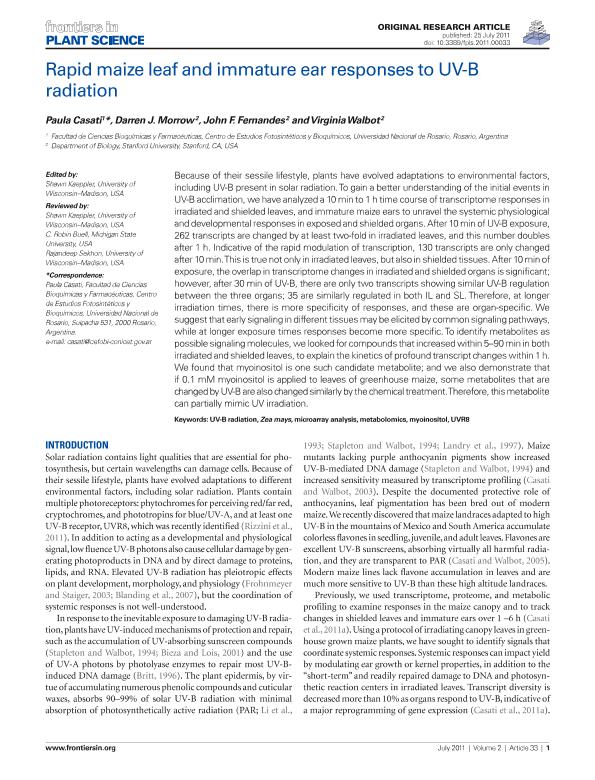Mostrar el registro sencillo del ítem
dc.contributor.author
Casati, Paula

dc.contributor.author
Morrow, Darren J.
dc.contributor.author
Fernandes, John F.
dc.contributor.author
Wallbot, Virginia
dc.date.available
2017-04-18T17:55:48Z
dc.date.issued
2011-07
dc.identifier.citation
Casati, Paula; Morrow, Darren J.; Fernandes, John F.; Wallbot, Virginia; Rapid maize leaf and immature ear responses to UV-B radiation; Frontiers Media; Frontiers in Plant Science; 2; 7-2011; 1-13; 33
dc.identifier.issn
1664-462X
dc.identifier.uri
http://hdl.handle.net/11336/15376
dc.description.abstract
Because of their sessile lifestyle, plants have evolved adaptations to environmental factors, including UV-B present in solar radiation. To gain a better understanding of the initial events in UV-B acclimation, we have analyzed a 10 min to 1 h time course of transcriptome responses in irradiated and shielded leaves, and immature maize ears to unravel the systemic physiological and developmental responses in exposed and shielded organs. After 10 min of UV-B exposure, 262 transcripts are changed by at least two-fold in irradiated leaves, and this number doubles after 1 h. Indicative of the rapid modulation of transcription, 130 transcripts are only changed after 10 min. This is true not only in irradiated leaves, but also in shielded tissues. After 10 min of exposure, the overlap in transcriptome changes in irradiated and shielded organs is significant; however, after 30 min of UV-B, there are only two transcripts showing similar UV-B regulation between the three organs; 35 are similarly regulated in both IL and SL. Therefore, at longer irradiation times, there is more specificity of responses, and these are organ-specific. We suggest that early signaling in different tissues may be elicited by common signaling pathways, while at longer exposure times responses become more specific. To identify metabolites as possible signaling molecules, we looked for compounds that increased within 5–90 min in both irradiated and shielded leaves, to explain the kinetics of profound transcript changes within 1 h. We found that myoinositol is one such candidate metabolite; and we also demonstrate that if 0.1 mM myoinositol is applied to leaves of greenhouse maize, some metabolites that are changed by UV-B are also changed similarly by the chemical treatment. Therefore, this metabolite can partially mimic UV irradiation.
dc.format
application/pdf
dc.language.iso
eng
dc.publisher
Frontiers Media
dc.rights
info:eu-repo/semantics/openAccess
dc.rights.uri
https://creativecommons.org/licenses/by-nc-sa/2.5/ar/
dc.subject
Uv-B Radiation
dc.subject
Zea Mays
dc.subject
Microarray Analysis
dc.subject
Metabolomics
dc.subject
Myoinositol
dc.subject
Uvr8
dc.subject.classification
Bioquímica y Biología Molecular

dc.subject.classification
Ciencias Biológicas

dc.subject.classification
CIENCIAS NATURALES Y EXACTAS

dc.title
Rapid maize leaf and immature ear responses to UV-B radiation
dc.type
info:eu-repo/semantics/article
dc.type
info:ar-repo/semantics/artículo
dc.type
info:eu-repo/semantics/publishedVersion
dc.date.updated
2017-04-18T14:01:48Z
dc.journal.volume
2
dc.journal.pagination
1-13; 33
dc.journal.pais
Suiza

dc.journal.ciudad
Lausanne
dc.description.fil
Fil: Casati, Paula. Consejo Nacional de Investigaciones Científicas y Técnicas. Centro Científico Tecnológico Rosario. Centro de Estudios Fotosintéticos y Bioquímicos (i); Argentina. Universidad Nacional de Rosario. Facultad de Ciencias Bioquímicas y Farmacéuticas; Argentina
dc.description.fil
Fil: Morrow, Darren J.. University Of Stanford; Estados Unidos
dc.description.fil
Fil: Fernandes, John F.. University Of Stanford; Estados Unidos
dc.description.fil
Fil: Wallbot, Virginia. University Of Stanford; Estados Unidos
dc.journal.title
Frontiers in Plant Science
dc.relation.alternativeid
info:eu-repo/semantics/altIdentifier/doi/http://dx.doi.org/10.3389/fpls.2011.00033
dc.relation.alternativeid
info:eu-repo/semantics/altIdentifier/url/http://journal.frontiersin.org/article/10.3389/fpls.2011.00033/full
Archivos asociados
